Table of Contents
Google has taken a significant step forward in the realm of artificial intelligence with the introduction of Gemini AI, a project that embodies the company’s most ambitious foray into AI to date. As described by Demis Hassabis, CEO and Co-Founder of Google DeepMind, Gemini represents the most capable and general model they’ve ever built.
This development marks a pivotal moment in Google’s journey as an AI-first company, showcasing their commitment to creating AI that is intuitive and helpful for everyone. Unlike previous models, Gemini was built from the ground up to be multimodal, capable of understanding and processing different types of information simultaneously.
With its advanced capabilities and enhanced reasoning abilities, Gemini AI is poised to make a significant impact in the AI landscape, directly competing with OpenAI’s ChatGPT.
What Is Gemini AI?
Gemini AI represents a significant leap forward in artificial intelligence, developed by Google DeepMind. It is the result of large-scale collaborative efforts by teams across Google, including Google Research.

The Vision Behind Google’s Most Capable AI Model
Gemini AI embodies Google DeepMind’s vision of creating an AI system that feels less like software and more like an intuitive expert helper or assistant. It was built from the ground up to be multimodal, enabling it to generalize and seamlessly understand, operate across, and combine different types of information, including text, code, audio, image, and video.
Native Multimodality: A Key Differentiator
The native multimodality of Gemini AI is a key differentiator, allowing it to understand and process multiple types of information simultaneously without the limitations of previous approaches that stitched together separate components for different modalities. This enables Gemini to perform complex reasoning across different types of inputs, making connections and drawing insights that would be impossible for earlier AI systems.
Gemini AI’s capabilities include:
- Processing and understanding multiple types of information simultaneously, such as text, images, audio, video, and code.
- Performing complex reasoning across different types of inputs, making it a significant advancement in artificial general intelligence.
- Moving beyond specialized AI toward more versatile and adaptable systems, reflecting Google’s strategic response to the limitations of existing AI models.
The Evolution of Google’s AI Strategy
The evolution of Google’s AI strategy has been marked by a series of strategic mergers and technological advancements. This shift has been pivotal in establishing Google as a leader in the AI landscape.
From Google Research to Google DeepMind
The merger of Google Research and DeepMind marked a significant milestone in Google’s AI journey, creating a powerhouse of AI expertise. As Sundar Pichai noted, “This new era of models represents one of the biggest science and engineering efforts we’ve undertaken as a company.” This consolidation enabled Google to tackle ambitious projects like Gemini, leveraging massive computational resources and interdisciplinary collaboration.
The formation of Google DeepMind has been instrumental in driving innovation, with Gemini being the first realization of the vision established earlier this year. This development underscores Google’s commitment to advancing AI technology.
| Key Developments | Description | Impact |
|---|---|---|
| Merger of Google Research and DeepMind | Consolidation of AI talent and resources | Accelerated innovation and capability to handle complex projects |
| Development of Gemini AI | First realization of Google DeepMind’s vision | Significant advancement in AI technology and competitive positioning |
Positioning in the Competitive AI Landscape
Google’s AI strategy has shifted from a primary focus on research to aggressively developing commercial applications. The development of Gemini represents Google’s response to competitive pressure from companies like OpenAI.
This strategic pivot reflects a broader industry shift toward foundation models adaptable to multiple use cases. Google’s development of Gemini demonstrates its recognition of AI as the next computing platform.
Gemini AI Models and Versions
Gemini AI is engineered in three sizes to fit a range of tasks and devices, from highly complex computations to on-device applications. This strategic development ensures that Gemini AI can be deployed across various environments.

Gemini Ultra: The Flagship Model
Gemini Ultra is the most capable model, designed for highly complex tasks that require sophisticated reasoning and extensive knowledge across multiple modalities. It’s the flagship model with the highest capabilities.
Gemini Pro: Balancing Power and Scalability
Gemini Pro strikes a balance between power and scalability, making it suitable for cloud services that need to handle a wide range of tasks efficiently. It’s designed to serve millions of users simultaneously.
Gemini Nano: Optimized for On-Device Applications
Gemini Nano is optimized for on-device tasks, bringing advanced AI capabilities to smartphones and edge devices while maintaining privacy. It’s the most efficient model for on-device applications, as seen in Pixel 8 Pro’s Recorder app and Gboard.
Technical Capabilities and Performance
With its advanced features, Gemini AI is redefining the boundaries of AI performance. Gemini Ultra’s capabilities have been extensively tested across a wide range of benchmarks, showcasing its exceptional performance and state-of-the-art results.
Benchmark Performance and State-of-the-Art Results
Gemini has demonstrated exceptional performance across a wide range of industry-standard benchmarks, surpassing previous state-of-the-art results on 30 out of 32 widely-used academic benchmarks in LLM research. This achievement underscores Gemini’s superior performance and its potential to revolutionize various applications.
Advanced Reasoning Capabilities
Gemini Ultra’s reasoning capabilities enable it to tackle complex problems in mathematics, physics, and other technical domains that require multi-step logical thinking and deep conceptual understanding. Its advanced reasoning abilities make it a powerful tool for solving intricate problems.
Multimodal Understanding
The model’s multimodal understanding allows it to process and reason about information presented in different formats simultaneously, enabling more natural and comprehensive interactions with users. This capability is particularly impressive as it achieves these results without relying on specialized OCR systems.
| Benchmark | Gemini Ultra Score | State-of-the-Art Score |
|---|---|---|
| MMLU | 90.0% | Previous SOTA |
| Multimodal Benchmarks | Exceptional Performance | Varying Scores |
Gemini AI Applications and Integrations
Google is rapidly expanding the reach of Gemini AI across its product ecosystem. This strategic move underscores Google’s commitment to leveraging AI to enhance user experience and drive innovation.
Integration with Google Products
Gemini AI is being integrated into key Google products, including Bard and Pixel. Bard now utilizes a fine-tuned version of Gemini Pro for advanced reasoning and planning. The Pixel 8 Pro is the first smartphone to run Gemini Nano locally, enabling features like automatic summarization in the Recorder app.
Developer API and Tools
Developers can access the Gemini API through Google AI Studio, offering flexible pricing tiers based on model size and usage. This enables developers to build innovative apps and tools that leverage Gemini’s capabilities.
Enterprise and Cloud Solutions
Enterprise customers can integrate Gemini into their operations via Google Cloud solutions, benefiting from advanced AI while maintaining security and compliance standards. This integration supports the development of custom AI applications tailored to specific business needs.
Specialized Capabilities for Developers
Developers can now leverage the power of Gemini AI for enhanced coding assistance, code generation, and more efficient coding tasks. This advanced AI model is designed to significantly improve developer productivity and code quality.
Advanced Coding Assistance and Generation
Gemini AI demonstrates exceptional capabilities in understanding, explaining, and generating high-quality code across multiple programming languages, including Python, Java, C++, and Go. The model’s ability to analyze existing codebases, identify bugs, and suggest optimizations enhances developer productivity. It can also explain complex code patterns in natural language, making it a valuable tool for developers.
AlphaCode2: Competitive Programming Solutions
Using a specialized version of Gemini AI, Google DeepMind created AlphaCode2, a more advanced code generation system that excels at solving competitive programming problems. AlphaCode2 shows significant improvements over its predecessor, solving nearly twice as many problems and outperforming 85% of competition participants. This breakthrough in automated competitive programming is a substantial advancement for developers tackling complex algorithmic challenges.
Google’s Approach to AI Safety and Responsibility
Google’s commitment to responsible AI is evident in its approach to developing Gemini. The company has implemented a comprehensive framework to ensure the safe and secure deployment of its AI technology.
Built-in Safety Measures and Testing
Gemini has undergone rigorous testing for bias, toxicity, and harmful outputs, demonstrating Google’s proactive approach to identifying and mitigating potential harms. The development team employed advanced adversarial testing techniques to identify critical safety issues before deployment. This included subjecting the model to challenging scenarios designed to expose vulnerabilities or undesirable behaviors.
Addressing Challenges in AI Ethics
Google is addressing ongoing challenges in AI ethics through collaboration with external experts, industry partners, and civil society groups. This collaborative approach recognizes that responsible AI development requires diverse perspectives and continuous evaluation. By working together, Google aims to create a secure framework for AI development that prioritizes safety and responsibility.
By integrating safety measures into the development process, Google is setting a new standard for AI safety and security. This approach not only enhances the reliability of Gemini but also fosters trust among users, which is crucial for the widespread adoption of AI technology.
Conclusion: The Future of Gemini AI in Google’s Ecosystem
With Gemini2.5, Google DeepMind has achieved state-of-the-art performance across a wide range of benchmarks. This milestone underscores Google’s commitment to advancing AI technology. The future roadmap for Gemini includes deeper integration across Google’s ecosystem, from Search and YouTube to Android and Google Cloud, creating a cohesive AI-powered experience for billions of users worldwide.
Google is actively encouraging developers to start building with Gemini through accessible APIs, comprehensive documentation, and flexible pricing models. This approach makes advanced AI capabilities available to organizations of all sizes. As Gemini continues to evolve, it will play a central role in Google’s strategy to maintain competitiveness in the AI space.
FAQ
What is the context window in Google’s cutting-edge models?
The context window refers to the ability of a model to understand and process information within a specific range or scope, enabling more accurate and relevant responses.
How does native multimodality enhance the capabilities of Google DeepMind models?
Native multimodality allows models to seamlessly process and integrate multiple forms of data, such as text, images, and audio, leading to more comprehensive understanding and generation capabilities.
What are the different versions of Google’s models, and how do they vary?
Google offers various models, including Ultra, Pro, and Nano, each designed for specific applications and use cases, ranging from high-performance tasks to on-device applications.
How does the Gemini API facilitate development and integration?
The Gemini API provides developers with a secure framework and tools to integrate Google’s models into their applications, enabling advanced coding assistance, generation, and other capabilities.
What measures are in place to ensure AI safety and responsibility in Google’s ecosystem?
Google has implemented built-in safety measures and testing protocols to address challenges in AI ethics and ensure the responsible development and deployment of its models.
How do Google’s models perform in benchmarks and state-of-the-art results?
Google’s models have demonstrated exceptional performance in various benchmarks, showcasing their advanced reasoning capabilities, multimodal understanding, and overall capabilities.
What are the benefits of using Google Cloud and Gemini API for enterprise solutions?
Google Cloud and Gemini API offer a range of benefits, including scalable and secure infrastructure, advanced capabilities, and integration with Google products, making them ideal for enterprise applications.









